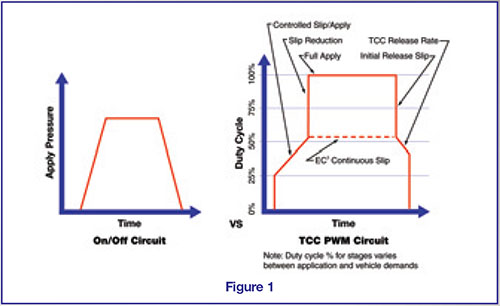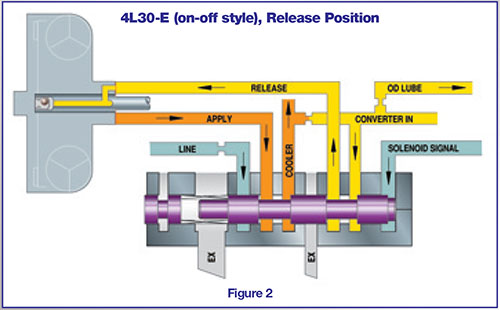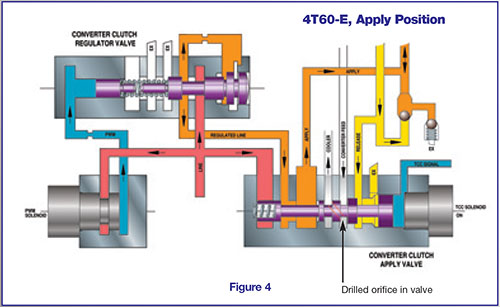GM TCC电路
莫拉·斯塔福德
哦,不!不会再有续集了!你没听过这样的说法吗:如果你见过一个,你就全都见过了?电影(想想《洛奇》系列)、真人秀(幸存者、单身汉、学徒)甚至电视剧都是如此。
传输?没错。以GM变矩器离合器电路为例。整个情节保持不变:应用和释放离合器。只有角色(阀门和螺线管)和单独的故事情节(开/关与脉宽调制、限制应用和/或释放压力等)发生了变化。因此,一旦了解了基本的TCC(变矩器离合器)电路,就可以很容易地破译更复杂的电路。乐动BBIN彩票
While there can be any number of ways to categorize GM converter clutch circuits, one basic way is by the solenoid control method. There are three basic circuit styles:
- 1电磁阀–1变矩器离合器启用(开/关)
- 2个电磁阀–1个变矩器离合器启用和1个PWM(脉宽调制)
- 1电磁阀–1变矩器离合器脉宽调制一般来说,此类别列表还显示了设计进展和控制复杂性。
So, why the circuit sequels? Was anything gained or lost with each subsequent style? Compare the early TH200C TCC circuit that used a TCC enable solenoid activated by a governor switch to one of today’s modern transmissions with a computer that analyzes a multitude of inputs (engine temperature,transmissiontemperature, brake switch, pressure switch, vehicle speed sensor, throttle position sensor, crankshaft position sensor, etc.) in order to duty cycle the TCC PWM solenoid. By monitoring the various operating parameters, the computer is better able to determine the best time for applying or releasing the converter clutch, but also at what rate and firmness the clutch should apply or release. (A line graph depicting the TCC apply and release of both these type circuits is shown in图1).
电路的先进性不仅提高了驾驶性能,而且提高了功率流效率和燃油经济性。通过使用PWM类型的电路,可以实现更平滑的接合和释放,并允许变矩器离合器更快地接通,而不会产生不良影响。消费者对更好的舒适性和更不频繁和更便宜的加油站停车的需求使得这些电路改进成为必要。
The on-off style4L30-E型provides a good example of a very basic TCC enable solenoid circuit. Only one on/off solenoid and one valve directly control the apply and release of the TCC. The converter clutch control valve, biased by solenoid signal fluid pressure and opposing spring force, routes fluid pressure into the apply or release circuits (see图2). 这将完全接合或释放变矩器离合器。可驾驶性“感觉”通过使用管路回路中的节流孔测量应用流量和使用涡轮轴中的止回球释放流量来控制。这允许变矩器压力和流量随管路压力变化。一些2000年以上的型号改为TCC PWM电磁阀和3 TCC阀式电路,类似于5L40-E型,稍后将讨论。
单个变矩器离合器启用电磁阀系统的更复杂版本是440/4T60型(见图3). 此回路有一个变矩器离合器接合阀,其功能与4L30-E非常相似,它将变矩器供油压力输送到变矩器离合器的接合或分离侧。然而,该阀有多个阀芯直径尺寸,并使用管路压力来辅助弹簧从电磁阀强制偏置变矩器离合器信号压力。这有助于防止阀门打滑,因为打滑可能导致闭锁投诉和/或转换器烧坏。此外,此回路使用变矩器离合器调节阀将变矩器供油压力调节为施加压力,然后再通过施加阀进入变矩器。平衡调节的施加压力与弹簧力、TCC蓄能器和TV压力相反,以控制调节阀。当此系统仍然完全接合或释放变矩器离合器时,它允许变矩器接合压力随扭矩需求而变化,并且离合器接合更平稳,以改善接合感觉。此回路的另一个特点是变矩器离合器排放阀,它将变矩器加注回路的最大压力控制在130磅/平方英寸。
In 1991 General Motors released the4T60-E型, which contained its first dual solenoid system utilizing PWM for the converter circuit (although some early units were still single solenoid, non-PWM). The design of this circuit is very similar to the 440/4T60, only refined in the area of clutch apply and release for an even smoother and more controlled engagement feel (see图4). 该回路仍包含相同类型的变矩器离合器接合阀,该阀以相同的方式将油流引导至变矩器离合器的接合或分离侧。
However, the converter clutch regulator valve is now two pieces, regulates line pressure instead of converter feed into apply pressure, and is controlled by a PWM solenoid. The PWM solenoid is controlled by the computer, and varies the duty cycle (on/off time) from 0% to 100%, thereby adjusting PWM pressure which positions the converter clutch regulator valve (instead of TV pressure in the 440/4T60). This allows the apply pressure to be more finely controlled based on multiple transmission inputs, and permits the converter clutch to be “slipped” on or off, depending upon driving needs. The addition of the PWM solenoid eliminated the need for a TCC accumulator. The transition from the 700-R4/4L60型开关式转换器电路乐动体育app下载LDsport
使能和PWM电磁阀控制电路与4T60-E非常相似。
虽然PWM电路允许变矩器离合器滑开和滑出并完全接合,但应注意的是,有些应用提供了EC3(电控容量离合器)PWM系统。PWM和EC3系统之间的液压电路相同,但计算机编程不同。EC3单元允许连续的低转速变矩器离合器打滑,这仍然可以提高燃油经济性,同时通过减少传动系扭转扰动进一步增强驾驶性能。体育投注在线
GM转换器电路的下一个主要进展是取消启用电磁阀,仅使用一个变矩器离合器脉宽调制电磁阀来控制接合阀、调节阀和通常附加的阀。一个很好的例子就是4T80-E型(见图5),这实际上是相同的液压更常见的4L80-E型。3日clut义务骑车太极拳PWM电磁脉冲ch oil into TCC control fluid pressure, which controls three valves: TCC enable, converter clutch control (apply), and converter clutch regulator. In the release position, the TCC enable valve directs feed limit pressure to the spring side of the apply valve. This prevents the apply valve from hunting between apply and release due to the pulsed pressure control.
As the computer starts increasing the duty cycle, the enable valve is the first to stroke, allowing the feed limit pressure to exhaust from the spring side of the apply valve. The apply valve is then stroked, redirecting release pressure from the converter to the enable valve for an orificed exhaust. Pulsed TCC control pressure then adjusts the regulator valve according to duty cycle, which regulates line into apply pressure that is routed to the converter for a controlled slip engagement. The converter feed limit valve prevents release pressure from exceeding 125 psi (93-107 psi on the 4L80-E). One potential hazard in this system is that if the apply valve becomes stuck in the “on” position, there will be no release pressure to the converter and overheating will occur.
5L40-E(参见图6)还使用一个变矩器离合器脉宽调制电磁阀来控制阀,并通过不同的液压端口消除了这种危险。脉冲变矩器离合器信号压力同时推动变矩器离合器控制阀和启用阀。但是,如果控制阀卡在应用位置,变矩器供油限制电路将确保变矩器仍有流量。在本设计中,还取消了转炉进料限位阀。
每一种电路都略有不同,但其发展已显示出对效率和驾驶性能的日益重视。哪一个是最好的?它们都有优点和缺点,但设计得最适合当时的技术传输。Sonnax提供了许多部件来替换和改进这些电路中的部件(参见图7).Someplace there’s a room full of screenwriters working on Rocky VI or the next Survivor series, and as long as there’s money to be saved, a new approach to try, or an improved design, you can guarantee another sequel to the GM converter clutch circuit.
Maura Stafford是Sonnax项目工程师和Sonnax TASC Force®(技术汽车专业委员会),一组公认的行业技术专家,变速器重建和Sonnax工业公司的技术人员。
相关单位
While Sonnax makes every effort to ensure the accuracy of technical articles at time of publication, we assume no liability for inaccuracies or for information which may become outdated or obsolete over time.






